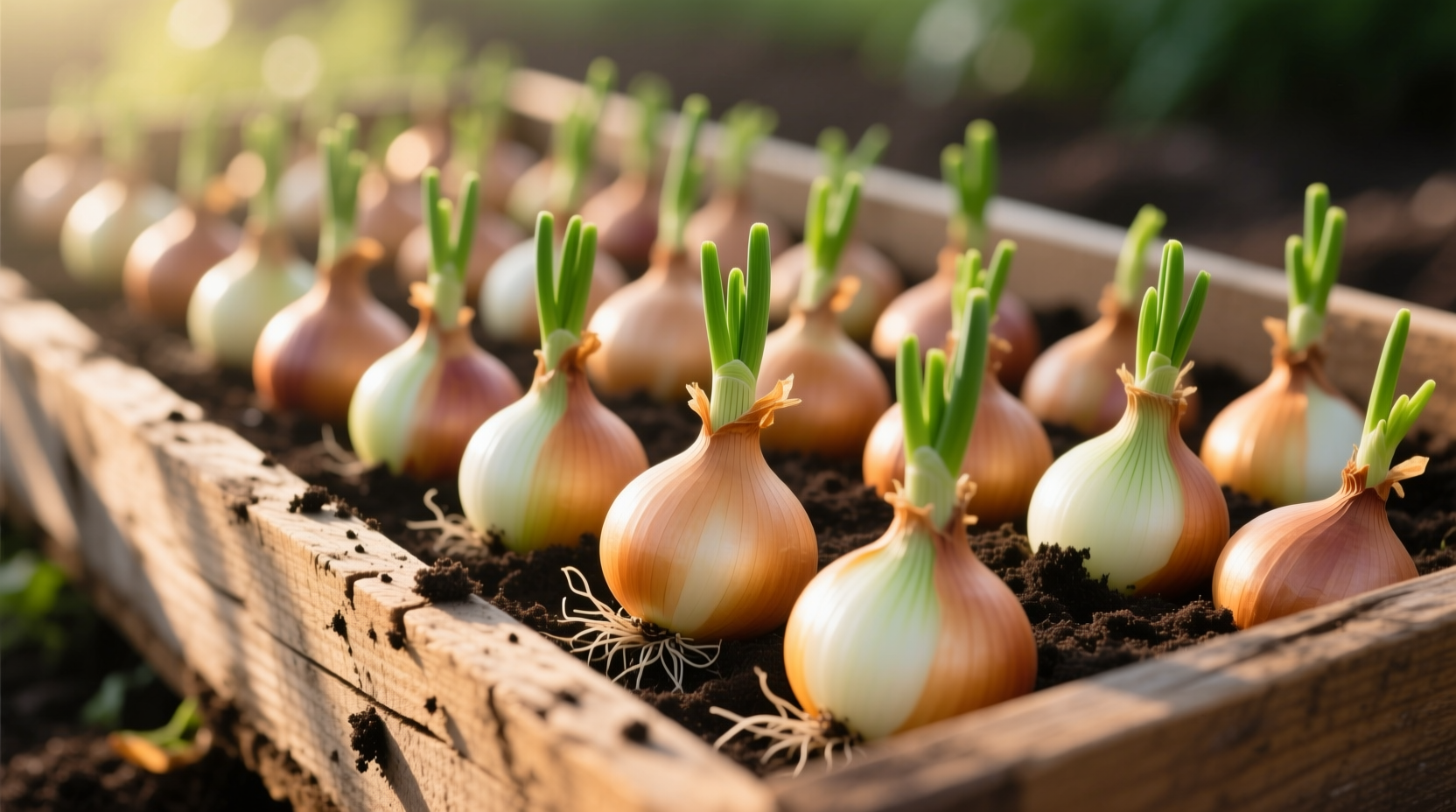For home gardeners seeking a dependable onion harvest with minimal effort, onion sets provide the perfect solution. Unlike starting from seeds, which requires careful temperature control and months of nurturing, sets give you a head start with pre-grown bulbs that focus energy on bulb development rather than sprouting. This comprehensive guide reveals exactly how to select, plant, and care for onion sets to maximize your harvest.
What Exactly Are Onion Sets?
Onion sets represent the middle ground between seeds and mature bulbs in the onion growing process. These small, dormant bulbs (typically 1/2 to 1 inch in diameter) were started from seed the previous season, then harvested and dried before going dormant. When planted correctly in your garden, they resume growth immediately, channeling energy directly into developing full-sized bulbs.
The Royal Horticultural Society confirms that onion sets typically produce harvestable bulbs 30-45 days faster than seed-started plants, making them ideal for regions with shorter growing seasons. Unlike seeds that require precise moisture and temperature conditions to germinate, sets tolerate less-than-perfect spring conditions while still producing reliable crops.

Onion Sets vs. Seeds vs. Transplants: Choosing Your Method
Understanding your options helps determine the best approach for your gardening situation. Each method has distinct advantages depending on your climate, experience level, and desired harvest timeline.
| Planting Method | Time to Harvest | Difficulty Level | Best For |
|---|---|---|---|
| Onion Sets | 90-120 days | Easy | Beginners, short-season climates, quick harvests |
| Seeds | 120-150 days | Advanced | Experienced gardeners, specific varieties, cost efficiency |
| Transplants | 100-130 days | Moderate | Gardeners with greenhouse access, larger plantings |
According to University of Minnesota Extension, sets work particularly well for home gardeners in USDA hardiness zones 3-6 where the growing season may not be long enough for seed-started onions to fully mature. The research shows that sets have a 75-85% success rate for first-time growers compared to 40-50% for seeds.
Optimal Planting Timeline for Maximum Yield
Timing your onion set planting correctly makes the difference between a bountiful harvest and disappointing results. The critical factor is planting early enough to establish strong root systems before the days lengthen, which triggers bulb formation.
For most regions, plant onion sets 4-6 weeks before your last expected frost date. This typically means:
- Northern climates (zones 3-5): Late March to mid-April
- Middle climates (zones 6-7): Mid-March to early April
- Southern climates (zones 8-10): Late January to mid-February
The USDA Plant Hardiness Zone Map provides precise timing guidance based on your specific location. Planting too late means your onions won't develop sufficient leaf growth before bulb formation begins, resulting in smaller harvests.
Step-by-Step Planting Instructions
Follow these research-backed steps for successful onion set planting:
Soil Preparation (1-2 Weeks Before Planting)
Onions thrive in loose, well-draining soil with a pH between 6.0-7.5. Amend heavy clay soils with 3-4 inches of compost worked into the top 8-12 inches of soil. Avoid fresh manure which can cause excessive leaf growth at the expense of bulb development.
Planting Technique
- Separate sets by size (keep similar sizes together)
- Create shallow trenches 1-2 inches deep
- Place sets with pointed end up, 4-6 inches apart
- Cover with soil, leaving just the tip visible
- Water thoroughly after planting
Research from Penn State Extension shows that planting depth directly affects bulb size—too shallow (less than 1 inch) causes sets to dry out, while too deep (over 2 inches) restricts bulb expansion. The optimal 1-2 inch depth balances moisture retention with unrestricted growth.
Avoiding Common Onion Set Mistakes
Even experienced gardeners encounter these preventable issues:
Planting Too Early in Cold Soil
While sets tolerate cool temperatures better than seeds, planting in soil below 40°F (4°C) causes premature sprouting followed by rot. Wait until soil temperatures reach at least 45°F (7°C) at planting depth.
Incorrect Spacing
Overcrowding (less than 4 inches apart) produces small bulbs as plants compete for resources. The Oregon State University Extension recommends 4 inches for standard varieties and 6 inches for larger varieties like 'Walla Walla'.
Neglecting Water Management
Onions need consistent moisture—about 1 inch of water weekly—but become susceptible to rot if overwatered. Reduce watering 2-3 weeks before harvest to allow bulbs to mature properly.
Troubleshooting Guide: Solving Onion Growing Problems
Why Aren't My Onions Bulbing?
This typically happens when:
- You planted the wrong variety for your day-length zone (long-day vs. short-day onions)
- Over-fertilization with nitrogen promoted leaf growth instead of bulbs
- Planting occurred too late in the season
Dealing with Pests and Diseases
Thrips and onion maggots pose the greatest threats. Prevent infestations by:
- Rotating planting locations annually
- Using floating row covers immediately after planting
- Applying beneficial nematodes for maggot prevention
Harvesting and Storage: Maximizing Your Onion Yield
Harvest when at least 50% of the tops have naturally fallen over and turned brown. Carefully dig bulbs and cure them in a warm, dry, well-ventilated area for 2-3 weeks. Properly cured onions store for 4-6 months in mesh bags at 32-40°F (0-4°C) with 65-70% humidity.
The National Onion Association reports that proper curing increases storage life by up to 50% compared to immediate refrigeration. Never skip the curing process—this critical step seals the outer layers and prevents rot during storage.











 浙公网安备
33010002000092号
浙公网安备
33010002000092号 浙B2-20120091-4
浙B2-20120091-4